◄ Carnets Geol. 13 (A02) ►
[Introduction]
[Geological setting]
[Ammonite biostratigraphy]
[Paleontological study]
[Bibliographic references] and ... [Plates]
Département des Sciences de la Terre, Université de Nice-Sophia
Antipolis. 28 Avenue Valrose F-06100 Nice (France)
Instituto de Geología, Universidad Nacional Autónoma de
México, Ciudad Universitaria, Coyoacán, 04510, México, D.F. (México)
C / Fang 85, Binissalem, Mallorca (Spain)
C/ La Fira 4, La Jana, Castelló (Spain)
Manuscript online since April 24, 2013
[Editor: Michel ;
copy editor: Bruno ; language editor: Simon
F. ]
Biostratigraphical and paleontological studies of lower Aptian material from the Eastern Iberian Chain (Spain) have revealed the presence of a new genus of micromorphic heteromorph ammonite: Xerticeras gen. nov. (type species: Xerticeras salasi sp. nov.). This new taxon comes from the Deshayesites deshayesi and Dufrenoya furcata ammonite zones. The size difference observed in the population is considered due to sexual dimorphism.
Ancyloceratina; heteromorphic ammonite; dimorphism; lower Cretaceous; Aptian; Spain.
G., J.A., J.J. & D. (2013).- Xerticeras gen. nov., a new genus of micromorphic heteromorph ammonite (Ancyloceratina, Ancyloceratidae) from the lower Aptian of Spain.- Carnets de Géologie [Notebooks on Geology], Brest, Article 2013/02 (CG2013_A02), p. 89-103.
Xerticeras gen. nov., un nuevo género de ammonite heteromorfo micromórfico (Ancyloceratina, Ancyloceratidae) del Aptiense inferior de España.- Los estudios bioestratigráficos y paleontológicos de los materiales del Aptiense inferior de la Cadena Ibérica oriental (España) han puesto de manifiesto la existencia de un nuevo género de un ammonite heteromorfo micromórfico: Xerticeras gen. nov. (especie tipo: Xerticeras salasi sp. nov.). Este nuevo taxón se presenta en las zonas de ammonites Deshayesites deshayesi y Dufrenoya furcata en el área de estudio. La diferencia de tamaño observada en la población se considera una expresión de dimorfismo sexual.
Ancyloceratina; ammonite heteromorfo; dimorfismo; Cretácico inferior; Aptiense; España.
Xerticeras gen. nov., un nouveau genre d'ammonite hétéromorphe micromorphe (Ancyloceratina, Ancyloceratidae) de l'Aptien inférieur d'Espagne.- L'étude biostratigraphique et paléontologique des dépôts de l'Aptien inférieur de la chaine ibérique orientale (Espagne) a révélé l'existence d'un nouveau genre d'ammonite hétéromorphe micromorphe : Xerticeras gen. nov. (espèce type : Xerticeras salasi sp. nov). Ce nouveau taxon est présent dans les zones d'ammonites à Deshayesites deshayesi et Dufrenoya furcata de la région étudiée. La différence de taille constatée dans la population est considérée comme l'expression d'un dimorphisme sexuel.
Ancyloceratina ; ammonites hétéromorphes ; dimorphisme ; Crétacé inférieur ; Aptien ; Espagne.
During the completion of the Ph.D. of the second author, J.A. , an unknown micromorphic heteromorph ammonoid was found in the lower Aptian material of the Mola Murada section, which is located close to the town of Xert. Some other specimens were also collected later by D. . In 2012, fieldwork was undertaken with the sole intention to collect additional specimens of this unknown taxon. In this last campaign more than one hundred specimens were collected. A new section containing this new taxon, Mola Rodona, was sampled in detail. As the distribution of heteromorph ammonoids appears to have been controlled by particular local factors and environmental conditions, the distribution of this species is sporadic and erratic. The description of this new taxon adds to the knowledge on the heteromorph ammonoids of the lower Aptian of the Maestrat.
The study area is located in the Maestrat Basin (Eastern Iberian Chain,
Eastern Spain). This basin was developed during the Late Jurassic-Early
Cretaceous rifting phase related to the opening of the Central Atlantic and
North Atlantic (e.g.,
and , 1993;
et al., 2001). This rifting stage
controlled the development of the basin, which was divided into seven sub-basins
( and , 1996),
which are shown in Figure 1 ![]() . The ammonoid
material studied in this paper comes
from the Salzedella Sub-basin, which is the depocenter of the Maestrat Basin.
The ammonoids were collected from the middle part of the Margas del
Forcall Formation that was deposited in a relatively deep water hemipelagic
environment. The sedimentation of the Forcall Formation coincides with an interval
of rapid
subsidence and also with the early Aptian Tethyan transgression (
et al., 2010). This formation shows an alternation of marls, marly limestones, limestones and silty/sandy
limestones, with abundant orbitolinids and ammonites. The ammonoid record of
Forcall Formation was recently studied in detail by
et al. (2009, 2010). The ammonoids studied in this paper come from two sections
in close proximity: Mola Murada (co-ordinates: 40º32'38.46"N, 0º10'33.95"E, Figs. 1
. The ammonoid
material studied in this paper comes
from the Salzedella Sub-basin, which is the depocenter of the Maestrat Basin.
The ammonoids were collected from the middle part of the Margas del
Forcall Formation that was deposited in a relatively deep water hemipelagic
environment. The sedimentation of the Forcall Formation coincides with an interval
of rapid
subsidence and also with the early Aptian Tethyan transgression (
et al., 2010). This formation shows an alternation of marls, marly limestones, limestones and silty/sandy
limestones, with abundant orbitolinids and ammonites. The ammonoid record of
Forcall Formation was recently studied in detail by
et al. (2009, 2010). The ammonoids studied in this paper come from two sections
in close proximity: Mola Murada (co-ordinates: 40º32'38.46"N, 0º10'33.95"E, Figs. 1 ![]() ,
2
,
2 ![]() and
4
and
4 ![]() ) and Mola Rodona (co-ordinates: 40º32'48.20"N, 0º10'42.75"E,
Figs. 1
) and Mola Rodona (co-ordinates: 40º32'48.20"N, 0º10'42.75"E,
Figs. 1 ![]() ,
3
,
3 ![]() and 4
and 4 ![]() ). Both sections are located near the village of
Xert, Baix Maestrat, Castelló.
). Both sections are located near the village of
Xert, Baix Maestrat, Castelló.
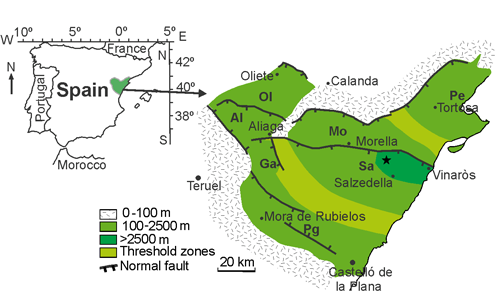
Click on thumbnail to enlarge the image.
Figure 1: Simplified geological map of the Maestrat Basin (modified after et al., 2001) that shows the seven sub-basins. The black star shows the location of the two studied sections.
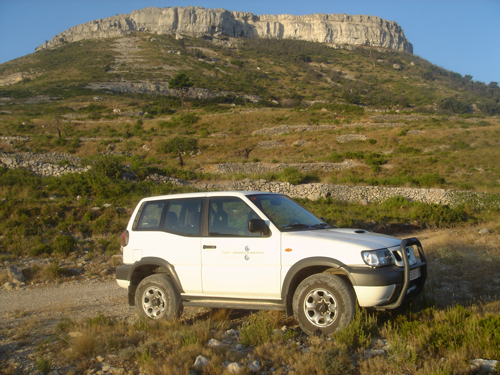
Click on thumbnail to enlarge the image.
Figure 2: Mola Murada.
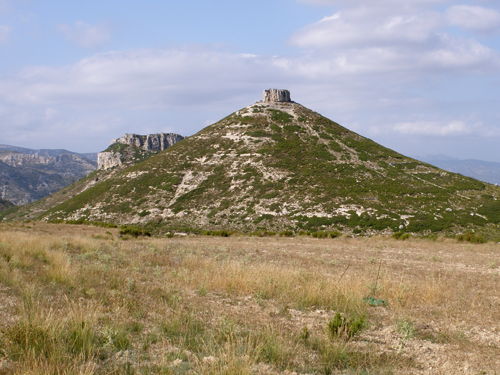
Click on thumbnail to enlarge the image.
Figure 3: Mola Rodona.
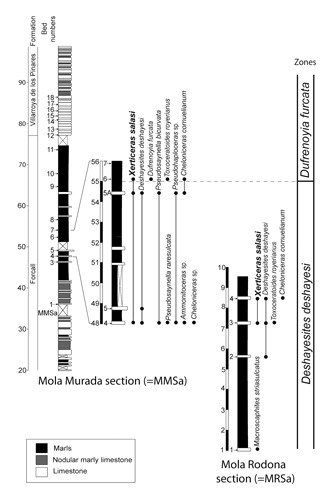
Click on thumbnail to enlarge the image.
Figure 4: Correlation across the two stratigraphic sections studied, Mola Murada (MMSa) and Mola Rodona (MRSa). Datum at the boundary of Deshayesites deshayesi and Dufrenoyia furcata zones. The more complete at Mola Murada (with its bed numbers) was modified after et al. (2010).
Two zones are recognized in the studied sections:
Discussion: The ammonoid assemblages from each zone are
typical of these biostratigraphical units. However, we must
remark on the presence of two specimens determined as Cheloniceras
sp. (Pl. 4 ![]() ,
figs. Q, S). In both of these specimens we can observe in the ventral region
the incipient differentiation between primary and secondary ribs (especially in
the Pl. 4
,
figs. Q, S). In both of these specimens we can observe in the ventral region
the incipient differentiation between primary and secondary ribs (especially in
the Pl. 4 ![]() ,
fig. Q). This characteristic becomes well developed in genus Epicheloniceras ,
1954. We consider these specimens as transitional forms between the genus Cheloniceras
, 1903, and Epicheloniceras
, 1954; they demonstrate a gradual
evolution between the two genera. In the present case the two specimens are clearly
closer to the Cheloniceras genus and are placed in this genus under open
nomenclature. A
similar situation, that shows this transitional evolution between Cheloniceras
, 1903, and Epicheloniceras
, 1954, has been reported by others workers (e.g.,
et al., 1998; et
al., 2012, 2013).
,
fig. Q). This characteristic becomes well developed in genus Epicheloniceras ,
1954. We consider these specimens as transitional forms between the genus Cheloniceras
, 1903, and Epicheloniceras
, 1954; they demonstrate a gradual
evolution between the two genera. In the present case the two specimens are clearly
closer to the Cheloniceras genus and are placed in this genus under open
nomenclature. A
similar situation, that shows this transitional evolution between Cheloniceras
, 1903, and Epicheloniceras
, 1954, has been reported by others workers (e.g.,
et al., 1998; et
al., 2012, 2013).
Order Ammonitida , 1884
Suborder Ancyloceratina , 1966
Superfamilly Ancyloceratoidea , 1871
Family Ancyloceratidae , 1871
Xerticeras gen. nov.
Derivatio nominis: From the village of Xert, Baix Maestrat, Castelló, Comunidad Valenciana, Eastern Spain.
Diagnosis: Micromorpic heteromorph ammonite with aspinoceratic or acrioceratic coiling and showing dimensional dimorphism. The crioconic spire is proportionally important and corresponds to the whole phragmocone. Ornamentation consists of fine, single, sharp, non-tuberculated ribs on all the parts of the shell, except on the hook where we can observe rare bifurcations or fasciculations. On the shaft, ribs are irregular; there are bundles of 2 to 4 raised ribs. On the crozier, the ribs are more evenly spaced.
Distribution: Lower Aptian, Deshayesites deshayesi and Dufrenoya furcata zones of Mola Murada and Mola Rodona sections (Eastern Iberian Chain, Eastern Spain).
Remarks, comparisons: We assign Xerticeras gen. nov. to the Ancyloceratidae because we believe that the families Acrioceratidae and Helicancylidae are most likely polyphyletic. In recent works, there are divergent views: et al. (2007) put Helicancylidae in synonymy with Ancyloceratidae, whereas (2009) considers Acrioceratidae as a synonym of Helicancylidae, and (2010) does not recognize the validity of Helicancylidae. In fact these two families contain heteromorphic ammonite genera with common characteristics, including their small size and an ornamentation consisting of non-tuberculate ribs and/or uni-, bi-, trituberculate ribs in more or less regular alternation. Moreover the phyletic lineages recognized by some authors who have recently studied ammonites belonging to these families (, 2004, 2006, 2009; , 2009; & , 2013) remain hypothetical and therefore cannot form the basis of evolutionary lineages. The Acrioceratidae and Helicancylidae very probably include both microconch taxa linked to a sexual dimorphism as well as taxa constituting full generic status.
Volgoceratoides & , 2002 (type species: Volgoceratoides schilovkensis & , 2002), is an Aptian micromorphic heteromorph genus with an aspinoceratic shell, ornamented with single ribs on the shaft and bifurcate ribs on the crozier. Ribs have one to two rows of tubercles (lateral and marginal).
Comparison of Xerticeras gen. nov. with the other small-sized Aptian heteromorph genera shows that this new genus is well defined:
We refer to the discussions of (1961), & (1977), (1986), (2002), & (2004) and (2009) about the taxonomic problems associated with these genera.
Some ornamental affinities can be also found with the acrioceratic genus Hoplocrioceras , 1924 (type-species: Hamites Phillipsi , 1829), populations of which have been described recently and figured by & (2010): the ornamentation consists of single fine ribs on the spire, which are fasciculate with peri-dorsal swellings and intermediate ribs on the shaft and the hook. But the species discussed by these authors is larger and occurs in the Lower Barremian of England and Germany.

Click on thumbnail to enlarge the image.
Figure 5: Xerticeras salasi gen. nov. sp. nov. A - specimen E(C)014 coll. ; B - specimen number 70 coll. . All from lower Aptian, Deshayesites deshayesi Zone from Mola Murada section.
Xerticeras salasi gen. nov. sp. nov.
Pl. 1 ![]() ,
figs. A-O; Pl. 2
,
figs. A-O; Pl. 2 ![]() ,
figs. A-U; Pl. 3
,
figs. A-U; Pl. 3 ![]() ,
figs. A-N, O-P, R; Fig. 5
,
figs. A-N, O-P, R; Fig. 5 ![]() ;
Table 1
;
Table 1
Holotype: Sample PUAB 88836 (Pl. 1 ![]() ,
fig. I), lower Aptian, Deshayesites
deshayesi Zone from Mola Murada section.
,
fig. I), lower Aptian, Deshayesites
deshayesi Zone from Mola Murada section.
Derivatio nominis: The species is dedicated to Ramon for his contributions to the geology of the Maestrat Basin.
Locus typicus: Mola Murada section.
Stratum typicum: Mola Murada section, bed number MMSa 4.
Studied material: 145 specimens, PUAB 88800 to 88822, PUAB 88835 to 88840, PUAB 88842 to 88868, PUAB 88890 to 88906, PUAB 88945 to 88951, PUAB 88959 to 88980, PUAB 89044 to 89047, lower Aptian, Deshayesites deshayesi Zone. Samples PUAB 88909 to 88930, PUAB 88990 to 89006, PUAB 89044 to 89047, lower Aptian, Dufrenoya furcata Zone [PUAB=Paleontology collections of Universitat Autònoma de Barcelona, Spain]. Sample E(C)014 coll. and samples 70 and 71 coll., lower Aptian, Deshayesites deshayesi Zone from Mola Murada section.
Diagnosis: Same as the genus.
Dimensions: Dimensions of some specimens are given in mm. The abbreviations used here are as follows: Ht = total height; ha = aperture height; M = macroconchs; m= microconchs; C = estimated
| PUAB | M m | Ht | ha | |
| 88835 | M | 29 | 6.3 | |
| 88836 | M | 24.45 | 7.3 | holotype |
| 88840 | M | C 27 | 6.5 | |
| 88842 | M | C 36 | 9.65 | |
| 88890 | M | 22.85 | 6.85 | |
| 88891 | M | 29.45 | 6.8 | |
| 88894 | M | 28.65 | 8.85 | |
| 88860 | M | C 23.45 | 6.5 | |
| 89044 | M | 22.2 | 6.75 | |
| 88802 | m | C 14.2 | 3.4 | |
| 88814 | m | C 14.5 | 3.6 | |
| 88837 | m | 15.9 | 3.55 | |
| 88838 | m | C 15 | 4.1 | |
| 88845 | m | C 14.9 | 3.3 | |
| 88846 | m | C 11.9 | 2.7 | |
| 88897 | m | C 13.6 | 3.6 |
Table 1: Dimension of some specimens of Xerticeras salasi gen. nov. sp. nov. (in mm)
Description: Very small heteromorphic ammonite; the adult macroconch is about 23 to 40 mm and the adult microconch is about 15 mm. The shell morphology is acrioceratic to aspinoceratic (, 1960; , 1986) with a spire that is proportionally important because it represents half of the height of the specimens.
In the most complete specimens it can be observed that the first ontogenetic stages of the shell morphology follow the typical aspinoceratic to acrioceratic development. The spiraled part of the shell constitutes the phragmocone. The shaft, which is very short, is more or less curved and links with a relatively opened crozier. The whorl section is elliptical.
Three successive ornamental stages can be observed:
Sutures lines cannot be studied.
No tubercles have been observed on any of the preserved parts.
Remarks, comparisons: Xerticeras salasi gen. nov. sp. nov. shows some variability affecting the strength of ribbing. We can observe the existence of forms with a little more regular and finer ribbing in which the groups of ribs arranged in ridges are slightly marked or almost non-existent whereas they are well marked in specimens showing a relative irregularity in the thickness of the ribs. The studied population also shows the presence of a small number of specimens characterized by their smaller size, about 15 mm high. The lack of forms of intermediate size leads us to consider these forms as possible microconchs.
With its very small size and shell morphology, Xerticeras salasi gen. nov. sp. nov. is close to Volgoceratoides schilovkensis & , 2002, but that species, described from the Volga River, shows bituberculated and unituberculate ribs on the shaft and regularly bifurcated ribs on the hook. Furthermore, on the returning part of the hook, the ribbing is simple. Volgoceratoides schilovkensis & , 2002, is known from the Deshayesites volgensis Zone of the Volga River Basin and from the Deshayesites forbesi Zone of Bulgaria ( & , 2002; & , 2013).
Occurence: Xerticeras salasi gen. nov. sp. nov. is only known from the Deshayesites deshayesi and Dufrenoya furcata zones of Eastern Iberian Chain, Eastern Spain.
At first we thank C. (Montélimar, France) for her reading and useful comments of the first draft of the manuscript. We also thank the two rewievers Prof. Dr. M.V. (Tbilissi, Georgia) and Prof. Dr. H.C. (Cape Town, Republic of South Africa) for their constructive remarks.
M.B. (1986).- Aptian ammonites from the Argentinian Austral Basin.- The subfamily Helicancylinae , 1894.- Annals of the South African Museum, Cape Town, vol. 96, n° 7, p. 271-314.
E. (2002).- Representatives in Romania of the genera Dissimilites , 1954 and Toxoceratoïdes , 1924 (Ancyloceratina, Ammonoidea).- Acta paleontologica Romaniae, Cluj-Napoca, vol. 3, p. 23-30.
E.Yu. & I.A. (2002).- New stratigraphic scheme of the lower Aptian in the Volga River middle courses.- Stratigraphy and Geological Correlation, Moscow, vol. 10, nº 6, p. 603-626.
D. (2009).- Description de Artareites landii nov. (Ammonoidea) du Barrémien supérieur de Majastre (Sud-Est de la France) et discussion sur les Helicancylidae , 1894.- Annales de Paléontologie, Paris, vol. 95, p. 139-163.
T., J.A., R., P.W., K. & E. (2010).- Sedimentary evolution of an Aptian syn-rift carbonate system (Maestrat Basin, E Spain): effects of accommodation and environmental change.- Geologica Acta, Barcelona, vol. 8, nº 3, p. 249-280.
R. (1960).- A monograph of the Ammonoidea of the Lower Greensand, part I.- Palaeontographical Society Monographs, London, vol. 113, i-xxvi, p. 1-44.
R., H.M. & M.I. (1998).- Observations on the lithostratigraphy and ammonite succession of the Aptian (Lower Cretaceous) Lower Greensand of Chale Bay, Isle of Wight, UK.- Cretaceous Research, London, vol. 19, nº 3-4, p. 511-535.
M. & V. (2013).- Lower Aptian ammonite biostratigraphy and potential for further studies of OAE1a in Bulgaria. In: P.W., B. & M. (eds.), Spatial patterns of change in Aptian carbonate platforms and related events.- Cretaceous Research, London, vol. 39, p. 47-69.
M.V. & Ph.J. (2004).- Heteromorphic ammonites from the Barremian and Aptian strata of Colombia.- Scripta Geologica, Leiden, vol. 128, p. 39-182.
M.V. & Ph.J. (2010).- New data on Early Cretaceous (Hauterivian-Barremian) heteromorphic ammonites from northern Germany.- Scripta Geologica, Leiden, vol. 140, p. 1-168.
J., R., M., G., M., S., P., Z. & J. (2007).- Fossilium Catalogus I: Animalia Pars 144, lower Cretaceous Ammonites III: Bochianitidae, Protancyloceratoidea, Ancyloceratoidea, Ptychoceratoidea.- Backhuys Publishers, Leiden, 381 p.
H.C. & W. (1977).- Cretaceous faunas from Zululand, South Africa and southern Mozambique. The Aptian Ancyloceratidae (Ammonoidea).- Annales of the South African Museum, Cape Town, vol. 73, n° 9, p. 215-359.
A. & S. (2013, in press).- The Barremian heteromorph ammonite Dissimilites from northern Italy: taxonomy and implications.- Acta Palaeontologica Polonica, Warszawa. dx.doi.org/10.4202/app.2012.0014
J.A., M., T., R., G., R. & A. (2009).- Biostratigraphic characterization by means of ammonoids of the lower Aptian Oceanic Anoxic Event (OAE 1a) in the eastern Iberian Chain (Maestrat Basin, eastern Spain).- Cretaceous Research, London, vol. 30, n° 4, p. 864-872.
J.A., M., T., R., G., F.J.-M.R., A. & R. (2010).- Lower Aptian ammonite biostratigraphy in the Maestrat Basin (Eastern Iberian Chain, Eastern Spain). A Tethyan transgressive record enhanced by synrift subsidence.- Geologica Acta, Barcelona, vol. 8, nº 3, p. 281-299.
J.A., M., J., J.M, T., R., G., F.J.-M.R. & R. (2012).- Lower Aptian ammonite and carbon isotope stratigraphy in the eastern Prebetic Domain (Betic Cordillera, southeastern Spain).- Geologica Acta, Barcelona, vol. 10, nº 4, p. 333-350.
J.A., R., M. & L.G. (2013).- Aptian (Lower Cretaceous) ammonite biostratigraphy of the Francisco Zarco Dam stratigraphic section (Durango State, northeast Mexico).- Journal of South American Earth Sciences, Amsterdam, vol. 42, p. 150-158.
R. & A. (1993).- Mesozoic extensional tectonics, stratigraphy, and crustal evolution during the Alpine cycle of the eastern Iberian basin.- Tectonophysics, Amsterdam, vol. 228, p. 33-55.
R. & J. (1996).- Rasgos estructurales principales de la cuenca cretácica inferior del Maestrazgo (Cordillera Ibérica oriental).- Geogaceta, Madrid, vol. 20, nº 7, p. 1704-1706.
R., J., R., C., A. & A. (2001).- Evolution of the Mesozoic central Iberian Rift System and its Cainozoic inversion (Iberian chain). In: P.A., W., A.H.F. & S. (eds.), Peri-Tethys Memoir 6: Peri-Tethyan rift/wrench basins and passive margins.- Mémoires du Muséum national d'Histoire naturelle, Paris, vol. 186, p. 145-186.
J. (2004).- Vers une nouvelle classification à fondement phylogénétique des ammonites hétéromorphes du Crétacé inférieur méditerranéen. Le cas des Crioceratitidae , 1871, nom. correct. , 1952, des Emericiceratidae fam. nov. et des Acrioceratidae fam. nov. (Ancylocerataceae , 1871).- Riviéra scientifique, Nice, vol. 88, p. 69-92.
J. (2006).- Nouvelle classification à fondement phylogénétique des ammonites hétéromorphes du Crétacé inférieur.- Annales du Muséum d'Histoire naturelle de Nice, t. XXI, p. 137-178.
J. (2009).- Ammonites nouvelles (Ancyloceratoidea) du Barrémien inférieur du sud-est de la France.- Riviéra scientifique, Nice, vol. 92, p. 49-64.
J. (2010).- Sur les familles des Helicancylidae , 1894, et des Acrioceratidae , 2004 ; réponses et précisions apportées au travail de , 2009.- Annales de Paléontologie, Paris, vol. 96, n° 2, p. 61-65.

Click on thumbnail to enlarge the image.
A-G: Xerticeras salasi gen. nov. sp. nov. microconch
A - lateral view of the specimen PUAB 88802, bed number MMSa 4. B - lateral view of the specimen PUAB 88814, bed number MMSa 4. C - lateral view of the specimen PUAB 88837, bed number MMSa 4. D - lateral view of the specimen PUAB 88838, bed number MMSa 4. E - lateral view of the specimen PUAB 88845, bed number MMSa 4. F - lateral view of the specimen PUAB 88846, bed number MMSa 4. G - lateral view of the specimen PUAB 88897, bed number MMSa 5a.
H-O: Xerticeras salasi gen. nov. sp. nov. macroconch
H - lateral view of the specimen PUAB 88835, bed number MMSa 4. I - lateral view of the holotype, the specimen PUAB 88836, bed number MMSa 4. J - lateral view of the specimen PUAB 88842, bed number MMSa 4. K - lateral view of the specimen PUAB 88840, bed number MMSa 4. L - lateral view of the specimen PUAB 88844, bed number MMSa 4. M - lateral view of the specimen PUAB 88891, bed number MMSa 5A. N - lateral view of the specimen PUAB 88890, bed number MMSa 4. O - lateral view of the specimen PUAB 88894, bed number MMSa 5A.
Scale bar 1 cm.
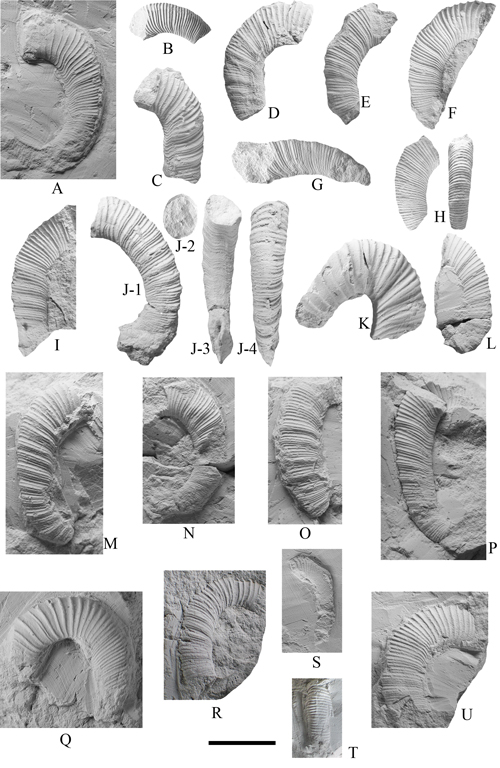
Click on thumbnail to enlarge the image.
A-R, T-U: Xerticeras salasi gen. nov. sp. nov. macroconch
A - lateral view of the specimen PUAB 88960, bed number MRSa 3. B - lateral view of the specimen PUAB 88801, bed number MMSa 4. C - lateral view of the specimen PUAB 88803, bed number MMSa 4. D - lateral view of the specimen PUAB 88804, bed number MMSa 4. E - lateral view of the specimen PUAB 88805, bed number MMSa 4. F - lateral view of the specimen PUAB 88806, bed number MMSa 4. G - lateral view of the specimen PUAB 88807, bed number MMSa 4. H - lateral view of the specimen PUAB 88818, bed number MMSa 4. I - lateral view of the specimen PUAB 88809, bed number MMSa 4. J - 1 lateral, 2 whorl section, 3 adoral and 4 ventral views of the specimen PUAB 88810, bed number MMSa 4. K - lateral view of the specimen PUAB 88819, bed number MMSa 4. L - lateral view of the specimen PUAB 88820, bed number MMSa 4. M - lateral view of the specimen PUAB 88839, bed number MMSa 4. N - lateral view of the specimen PUAB 88843, bed number MMSa 4. O - lateral view of the specimen PUAB 88848, bed number MMSa 4. P - lateral view of the specimen PUAB 88850, bed number MMSa 4. Q - lateral view of the specimen PUAB 88855, bed number MMSa 4. R - lateral view of the specimen PUAB 88892, bed number MMSa 5A. T - lateral view of the specimen PUAB 88904, bed number MMSa 5A. U - lateral view of the specimen PUAB 88898, bed number MMSa 5A.
S: Xerticeras salasi microconch, lateral view of the specimen PUAB 88896, bed number MMSa 5A.
Scale bar 1 cm.
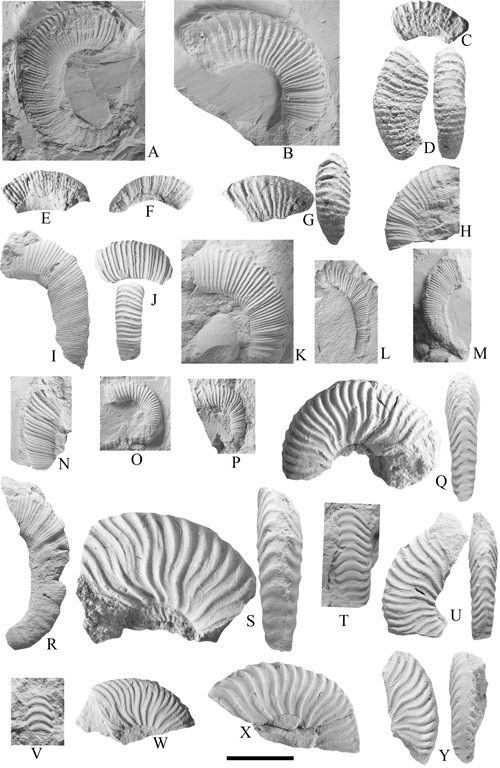
Click on thumbnail to enlarge the image.
A-N, R: Xerticeras salasi gen. nov. sp. nov. macroconch
A - lateral view of the specimen PUAB 89044, bed number MMSa 4. B - lateral view of the specimen PUAB 88900, bed number MMSa 5A. C - lateral view of the specimen PUAB 88894, bed number MMSa 6. D - lateral and ventral views of the specimen PUAB 88899, bed number MMSa 6. E - lateral view of the specimen PUAB 88913, bed number MMSa 6. F - lateral view of the specimen PUAB 88929, bed number MMSa 6. G - lateral and ventral views of the specimen PUAB 89006, bed number MMSa 6. H - lateral view of the specimen PUAB 88947, bed number MRSa 3. I - lateral view of the specimen PUAB 88945, bed number MRSa 3. J - lateral and ventral views of the specimen PUAB 88949, bed number MRSa 3. K - lateral view of the specimen PUAB 88961, bed number MRSa 3. L - lateral view of the specimen PUAB 88962, bed number MRSa 3. M - lateral view of the specimen PUAB 88966, bed number MRSa 3. N - lateral view of the specimen PUAB 88967, bed number MRSa 3. R - lateral view of the specimen PUAB 88980, bed number MRSa 3.
O-P: Xerticeras salasi gen. nov. sp. nov. microconch
O - lateral view of the specimen PUAB 88972, bed number MRSa 3. P - lateral view of the specimen PUAB 88976, bed number MRSa 3.
Q, S-Y: Deshayesites deshayesi (d', 1841)
Q - lateral and ventral views of the specimen PUAB 88823, bed number MMSa 4. S - lateral and ventral views of the specimen PUAB 88824, bed number MMSa 4. T - ventral view of the specimen PUAB 88874, bed number MMSa 4. U - lateral and ventral views of the specimen PUAB 88881, bed number MMSa 5. V - ventral view of the specimen PUAB 88877, bed number MMSa 5. W - lateral view of the specimen PUAB 88879, bed number MMSa 5. X - lateral view of the specimen PUAB 88885, bed number MMSa 5. Y - lateral and ventral views of the specimen PUAB 88884, bed number MMSa 5.
Scale bar 1 cm.
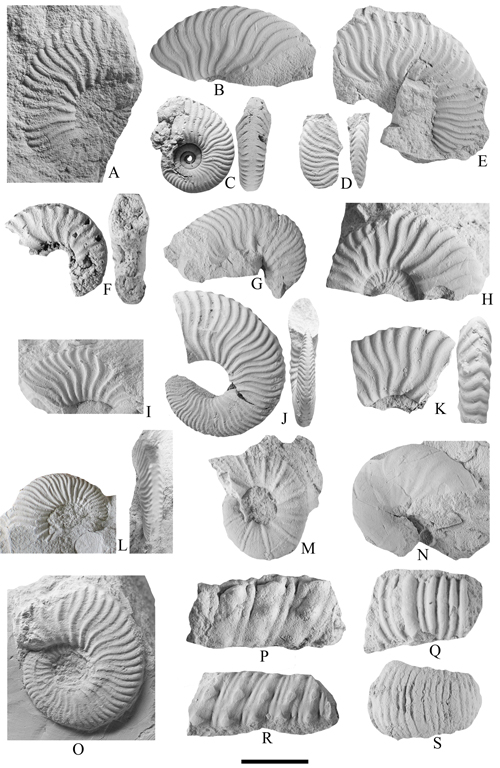
Click on thumbnail to enlarge the image.
A-B, D-E, G-L, O: Deshayesites deshayesi (d', 1841)
A - lateral view of the specimen PUAB 88876, bed number MMSa 5. B - lateral view of the specimen PUAB 88886, bed number MMSa 5A. D - lateral and ventral views of the specimen PUAB 88936, bed number MRSa 2. E - lateral view of the specimen PUAB 88887, bed number MMSa 5A. G - lateral view of the specimen PUAB 88937, bed number MRSa 2. H - lateral view of the specimen PUAB 88981, bed number MRSa 3. I - lateral view of the specimen PUAB 88943, bed number MRSa 2. J - lateral and ventral views of the specimen PUAB 88952, bed number MRSa 3. K - lateral and ventral views of the specimen PUAB 88956, bed number MRSa 3. L - lateral and ventral views of the specimen PUAB 88984, bed number MRSa 3. O - lateral view of the specimen PUAB 88986, bed number MRSa 3.
C, F: Dufrenoyia furcata (J. de C. , 1836)
C - lateral and ventral views of the specimen PUAB 88934, bed number MMSa 6. F - lateral and ventral views of the specimen PUAB 89010, bed number MMSa 6.
M: Pseudohaploceras sp., lateral view of the specimen PUAB 88828, bed number MMSa 4.
N: Pseudosaynella sp., lateral view of the specimen PUAB 88889, bed number MMSa 5A.
P, R: Toxoceratoides royerianus (d', 1841)
P - lateral view of the specimen PUAB 89014, bed number MMSa 6. R - lateral view of the specimen PUAB 88958, bed number MMSa 3.
Q, S: Cheloniceras sp.
Q - ventral view of the specimen PUAB 88870, bed number MMSa 4. S - ventral view of the specimen PUAB 89016, bed number MMSa 6.
Scale bar 1 cm.